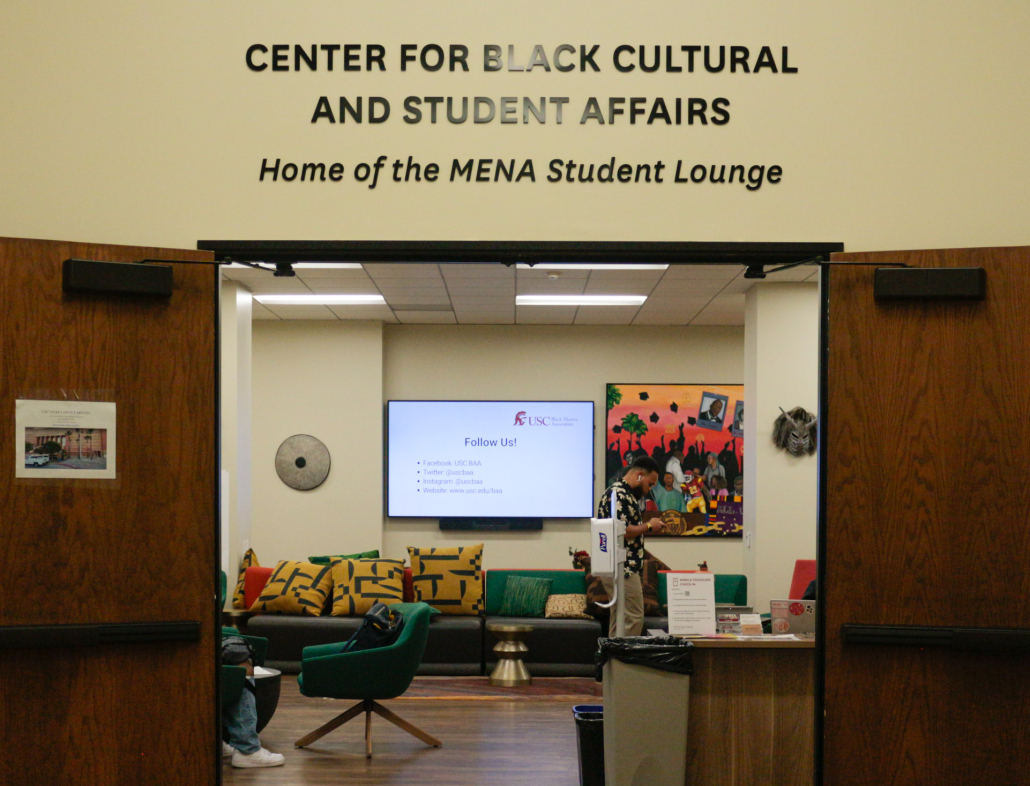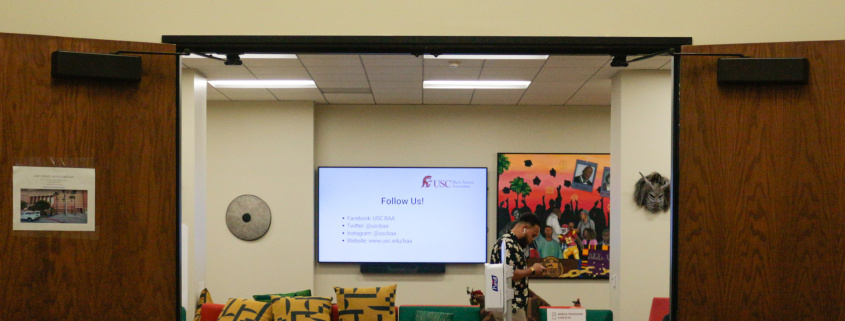Students continue to push for cultural center renovation

When she was growing up in Los Angeles, Paris Wise, a senior majoring in journalism, said she was never able to find a “close-knit” Native American community. That changed when she joined the Native American Student Assembly after arriving at USC. NASA was one of the many student assemblies, including the Center for Black Cultural and Student Affairs and the Asian Pacific American Student Services, that received a newly decorated space as students returned to campus for Fall 2021.
The USC Student Equity and Inclusion Programs launched the renovations following a “big push” from students, Wise, NASA’s director of public relations, said.
On Aug. 4, 2020 President Carol Folt wrote in a communitywide email about the University’s initiatives “to confront systemic racism at USC” and the expansion of “programming and space” for marginalized communities on campus.
Physical spaces for the Center for Black Cultural and Student Affairs, Asian Pacific American Student Services, LGBTQ+ Resource Center and the First Gen+ Success Center, were remodeled at the beginning of summer 2021. The remodeled centers included improvements in furnishing and flooring along with expansions in space and relocations.
The push for remodeling and additional student resources stemmed from persistent student advocacy. Center Supervisor for CBCSA Damarea Parker said social movements, such as the Black Lives Matter movement, were a main driver for the cosmetic changes within cultural centers.
“There were a lot of things going on in the world,” Parker said. “There was the Black Lives Matter movement and other movements that were happening, and then also the students as well [were] advocating for more space to be able to engage and connect.”
CBCSA, once located on the fourth floor of the Student Union, has now replaced the former Ticket Office on the building’s first floor. Parker said the remodeled space is important to the overall well-being of students involved with the center.
“We consider ourselves to be the hub for the Black community … and other folks who identify or allies who identify too, and it’s super important because this is where students come and can unapologetically be them,” Parker said. “They also get a chance to learn, grow, experience, do a number of events, programs — all the things that enrich their student experience.”
The additional space in the new CBCSA lounge allows the center to host a number of events — such as panels, discussions and mix-and-mingle gatherings. New modular furniture allows the center to set up various layouts to accommodate different events, Parker said.
However, Wise said more work needs to be done at USC and she wishes the University initiated more of its own projects to create a more accepting culture on campus in addition to supporting existing student-led initiatives.

Despite the new additions, other members of the organizations — including Wise — are pushing for more changes to the cultural centers such as increased space, money for scholarships, additional centers and University support.
Two new lounges — the Native American & Pasifika Student Lounge and the Middle Eastern and North African Student Lounge — opened this semester on the Student Union’s fouth floor and within the CBCSA center, respectively. Maracea Chase, a senior majoring in cinema and media studies, serves as the executive director of NASA. She said the new lounge was established in conjunction with the demand for more representation and resources for Native students at USC.
“One of the things that we did [at the] forefront was to be able to incorporate into a student assembly with [the Undergraduate Student Government],” Chase said. “Thankfully, after that incorporation, that’s when we were told we were going to be getting a space in the Student Union Center, which is not something that we were expecting, but it definitely did happen, for good reason.”
Prior to the Native American student lounge, NASA occupied a room in the University Religious Center. However, Chase said the new student lounge allows her to see other Native students on a day-to-day basis, rather than just during meetings or events.
“I love going into the space and being able to see other people, other Natives, and just catch up, do homework together,” Chase said.
Wise said the creation of the lounges was crucial for inclusion and hopes for the cultural center to accommodate a growing population of Native American students at USC.
“The lounge that we have is really a big deal because it is a physical representation of how our community is able to take up space, and that space is being made for us at what is a predominantly white institution,” Wise said.
The Middle Eastern and North African Student lounge, located within the CBCSA space, was also a new addition to the USC Student Equity and Inclusion Programs. Anthony Khoory, a junior majoring in sociology, said it’s vital for student populations that are underrepresented to have space where they can come together and express themselves.
“When you have other people from your background … having events where there’s elements of your culture, like food, you feel like USC is your home and not just a place that you’re going to get the degree,” Khoory said.
Khoory began advocating for space and resources for Middle Eastern and North African students in 2019 after questioning the lack of a space for students with Middle Eastern and North African backgrounds.
According to Khoory, he first approached the University’s Director of Cultural Centers in 2019, asking for a space with a full-time staff for Middle Eastern and North African students.
The result of Khoory’s advocacy was the creation of the Middle Eastern and North African lounge, which opened in Fall 2021 on the first floor of the Student Union. Despite the new space, Khoory said giving the students the room is not enough.
“The MENA lounge is small,” Khoory said. “When we had an event — our first open house event — it got so full that we had to go into the rest of the CBCSA because it was just so many people. Especially with COVID guidelines, you could barely fit 15 to 20 people in this space, and we have thousands in the college who identify as MENA.”
Khoory said he is still “grateful” for the new lounge space and that people are using it.
“There’s midterms, you just want a place to hang out and drink Arabic coffee and eat baklava,” he said.
The Asian Pacific American Student Services lounge is another space that was remodeled over the summer. Kelvin Nguyen, a junior majoring in health and human sciences, said the newly revamped APASS lounge was a place he could safely and conveniently relax, especially as the ongoing coronavirus pandemic and living off-campus made it difficult to find a location to relax or charge electronics.
“This place is really useful for me to actually just sit down and do my work without worrying about where I have to go,” Nguyen said.
Nguyen said, before he started going to APASS, he struggled to find work spaces elsewhere on campus.
“If you want to rent a room at one of the libraries, you have to book it in advance,” Nguyen said. “It’s really awkward if you don’t even know what you’re doing this week.”
Unlike other centers remodeled over the summer, La CASA’s physical space was renovated three years ago. Located in the Student Union, the name was changed from “El Centro Chicano” to the Latinx/Chicanx Center for Advocacy and Student Affairs — “La CASA” — in 2019.
For Abraham Flores, a freshman majoring in journalism, La CASA has “always been a home.” In the La CASA lounge, murals, including illustrations of prominent Latinx figures, painted by Latinx artists cover the walls. But one particular mural stands out to Flores because it makes him feel connected to his relationship with his parents.
“There’s a mural on the wall, and it’s like a hole in the roof [with] monarch butterflies escaping,” Flores said. “Monarch butterflies are really important in, at least, my culture because they migrate to try to give their children, who are unborn at the time, a better life, and sometimes they don’t make it all the way to their destination. That’s the story of the monarch butterfly. It’s incredible and the fact that it’s a little thing there, it’s really nice.”
According to the students, other cultural centers also hope to install new decorations like La CASA’s murals.
At CBCSA, Parker said the center plans to maximize the use of its space by collaborating with other cultural centers.
“We’re really looking at college students with multiple identities, and so we’re making sure we touch base with those, too, in collaboration with our other cultural centers,” Parker said.
At NASA’s student lounge, students hope to see continuous expansion, to include as many communities on campus as possible.
“Hopefully, sometime in the future, we will have the space decorated, both with local tribes and the tribes of our students,” Chase said. “That will be an amazing space to hold future events to celebrate representation and facilitate conversations about how to support Native students more.”
Wise said, while the new spaces are a “big deal,” she hopes the University will make an effort to support minority students beyond the expansion and remodeling of the on-campus cultural centers.
“It’s not perfect. There’s still so much work to be done,” Wise said. “It’s a shame that it has to be put up on the students. I think a lot of the cultural centers need a lot more support in that way — especially the newer ones, and it’s just a first step, so I really look forward to seeing what else comes about.”
Sasha Ryu contributed to this report.

